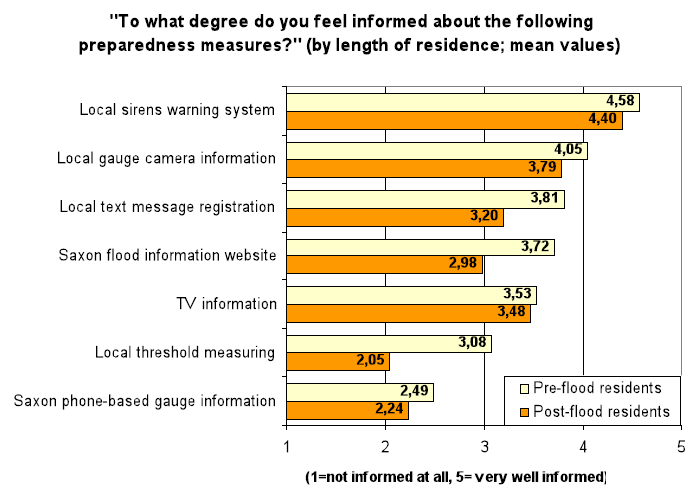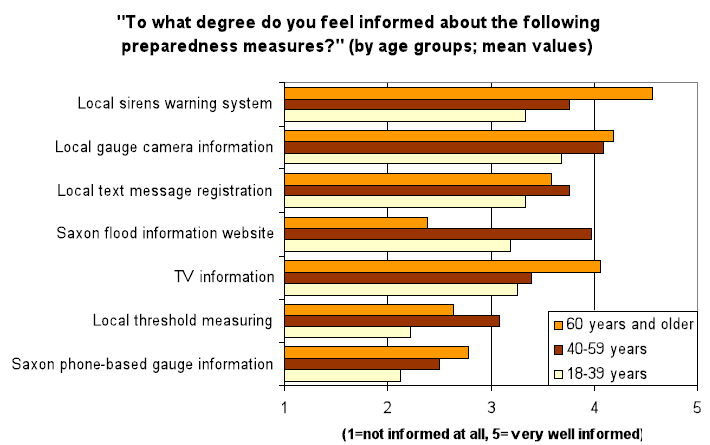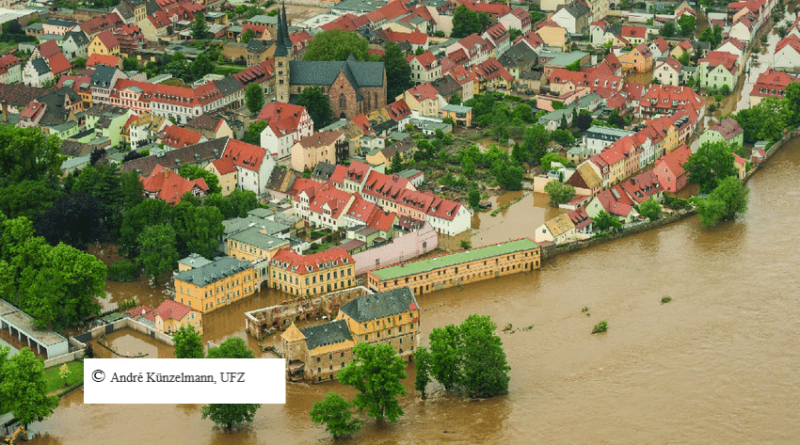Flood risk management and communication: Grimma town
The Elba flood in 2002
Grimma, Saxony, Germany is a small town located in the Mulde river area, one of the Elbe river’s tributaries, and was strongly affected by its flooding in 2002. The flood, with a return period of 200 to 250 years, was very severe. Still, the town center’s high exposure, being located close to the river and having almost no structural measures protecting the town and its inhabitants, intensified the destructions. The flood entered many buildings, from private houses to shops and historical buildings with a depth of up to 3.5 meters, and left damage of approximately €234 million.
Taking measures
To prevent the same destructions as of the floods of 2002, almost immediately after cleaning up the demolitions, the Saxon State Ministry of the Environment and Agriculture (SMUL) initiated the development of new flood protection along the major rivers in Saxony to protect settlements against floods up to a return period of 100 years. But reaching a consensus was not easy. A lengthy public debate was held, and several options were discussed. As Schildt studied in 2006, the state agencies’ most recommended solution was a protection wall. Still, many inhabitants and the municipality rejected it, who were afraid of its negative influence on the cultural heritage, touristic importance, and appealing character of the town of Grimma. Finally, it was agreed upon that under the supervision of the State Reservoir Administration (LTV), 47 flood protection defenses (HWSK), mainly structural measures, such as new or heightened dikes or flood protection walls, should be developed.
Moreover, based on Meyer et al., a flood early warning system (FEWS) for the whole of Saxony was established, run by the Saxon State Agency for Environment, Agriculture, and Geology LfULG (Meyer and Kuhlicke 2008). An article about the flood early warning systems is also featured on this website, which could be found here. This local flood warning system operates independently from the state’s flood protection center’s official warning system, with relatively low running costs of about €4,200 annually. Grimma’s flood warning system consists of five components:
- five central hooter sirens on town roofs, all tested once a month,
- autonomous text messages for mobile phones,
- a camera shooting the river gauge with live streaming on the municipal website,
- continuous information in situations of approaching flood conditions on local TV, and
- door threshold measuring to assess at which river height the water will inundate the respective house.
An essential notion in the warning system’s components is the necessity of people’s involvement and risk communication, consisting of their dynamic behavior (such as registering for text messages) and training (like understanding the meaning behind door threshold measurements). An article on risk communication is also available on the website, which could be found here.
Investigation on risk communication
In 2008 a study was carried out in Grimma to find out about the knowledge about the mitigation measures, the degree of the actual application of personal preparedness and prevention measures, the acceptance of public risk communication efforts among the local population, and their effects on people’s behavior. The following paragraphs explain the different findings of this study.
a) People’s perception of different measures
The measures people were supposed to do regarding the town’s flood risk management scheme were taking insurance, moving the electric and heating devices to the upper floors, having equipment such as pumps and sandbags at home, measuring door threshold, and registering for receiving flood warning messages.
At the beginning of the survey, people were asked if they have done any flood risk management measures. The results showed that 63% of the people could not mention any prevention measure they had applied. Just five and four percent of the people remembered registering for the text message and door thresholds measurements, respectively.
In the next step, people were asked directly if they have done specific measures. As the figure below shows, the results completely changed, and the actual application of prevention measures was much higher than the people’s self-assessment. Another implication is that the inhabitants do not regard the actions they have taken as part of the town’s flood risk management strategy.
The interesting point is that, according to this figure, the two significant elements of the local warning system, which are text message and threshold measurement, are the ones with the least relevance for the local population. Simultaneously, these are measures requiring relatively low costs and commitment compared to moving electronic devices or heating to higher floors.

b) The effect of the people’s length of residence
After the city’s reconstruction after the flood of 2002, many new people migrated to the Grimma town. A question arising in the mind of the scientists conducting the study was comparing the old inhabitants’ and recent immigrants’ awareness. As a result, the questionnaire’s results were restudied, considering the people’s length of residence in the town. The results are shown in figure 2.
As expected, the old residents were better informed, especially regarding the threshold measuring. Still, it does not show whether people were genuinely aware of this measure’s aim. Also, the immigrants were mostly aware of the sirens, resulting from the regular monthly tests of the system.

c) Study of the effect of age
Moreover, age-specific differences in the degree of flood-related information were expected. Therefore the scientists restudied the results, this time considering the people’s age. The figure below confirms this hypothesis but also provides other results. Based on this figure, it is not the older generation that feels rather poorly informed, but, in almost all categories, it is the younger generation of people between 18 to 39 years who perceives its degree of knowledge as moderate or even not reasonable.
The older generation considers itself better informed of all the measures, except for the local text message registration, the internet-based information system, and the threshold measurement. Moreover, the information on the sirens warning system increases with people’s age.
The critical point is that although many older respondents knew about the opportunity to receive flood-related text messages, most of them did not possess a mobile phone. They thus could not make use of text messages. Among the youngest generation, the situation was just the opposite. Therefore, it can be said that having a mobile phone did not necessarily imply knowledge about mobile phone-based warnings and information.

References:
- C. Höppner et al., “Risk Communication and Natural Hazards,” Birmensdorf, Switzerland, 2010.




